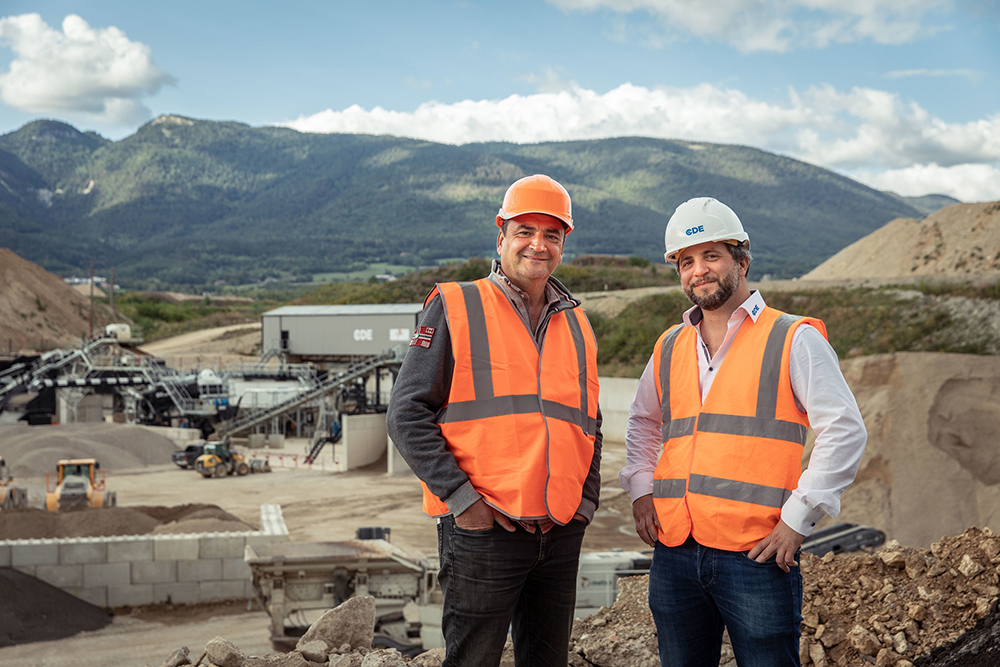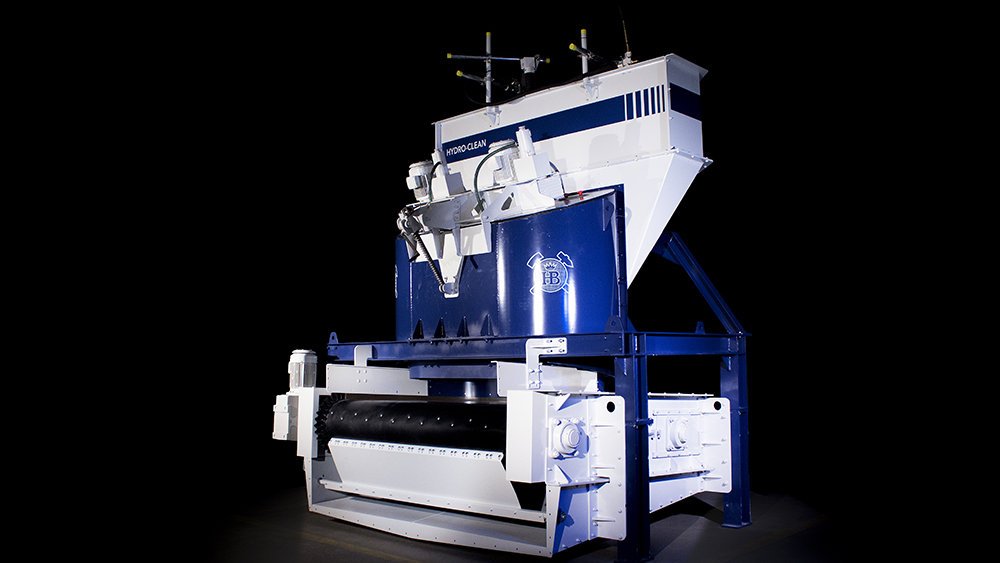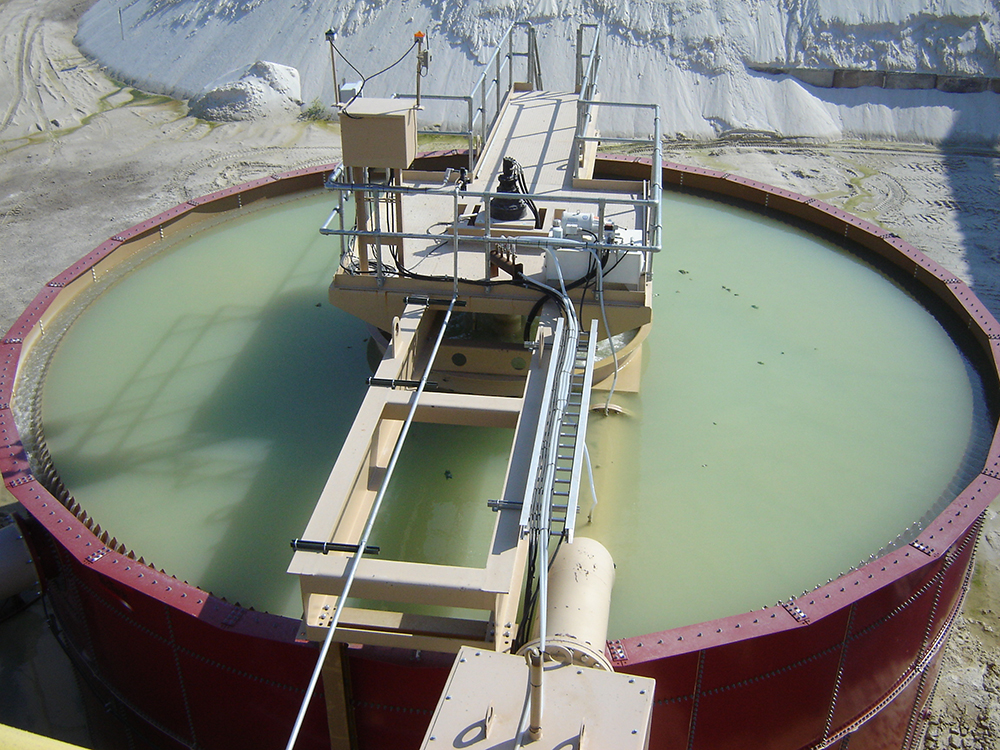
Pélichet Albert, a public works contractor and aggregates producer based in western France, is using a new washing plant at its Chauvilly site that will enable it to divert up to 200,000 tonnes per year of inert construction and demolition (C&D) waste from landfill.
Pélichet Albert says a recently commissioned, new 160 tonnes/hour plant from Northern Ireland-based wet processing equipment manufacturer CDE will provide additional revenue from the production of higher value products.
The company’s former quarry site at Chauvilly became the base of its recycling operations in 1998 and has processed C&D waste material sourced from Pélichet’s business activities ever since.
Founded in 1921, Pélichet operates a circular economy business model with operations in demolition, groundworks, landfill and construction & demolition (C&D) waste recycling. The company has adapted its business over the last two decades to pay greater attention to recycled materials for use in the construction industry. This follows the introduction of local legislation in the Le Pays de Gex region in the early 1990s, which halted the extraction of finite natural resources.
CEO Jérôme Pélichet commented on his company’s link-up with CDE: “More than a supplier, we wanted to find a partner to come on this journey with us; a company that would oversee the process, from design through to commissioning on site, and work in conjunction with us to fully understand our operation and our business objectives.”
An abundant stockpile of heavily contaminated historic landfill material presented a challenge.
“We encountered the problem of quality,” Pélichet added, explaining the company’s old plant and process before it commissioned the new wet processing plant. “So, we took a different approach with the acquisition of this new installation. It allows us to manufacture quality materials that better meet the demands of our clients.”
He selected CDE as a partner after visiting a C&D waste recycling operation that utilised a CDE plant during a trip to the UK.
“We saw first-hand the challenging feed material CDE plant was capable of processing and extracting high-value aggregates from,” he said. “We had access to similar grade material, but until that point didn’t have the technology to process it.”
The Pélichet plant mainly processes two types of feed material; firstly, excavated materials from its construction works and demolition operations, including 0-300mm clay-bound, silica-limestone material and, secondly, 0-40mm crushed C&D waste. The presence of plastics and other organic contaminants retained after processing was resulting in second-rate products with lower value.
Water availability proved to be another significant challenge at the company’s Chauvilly site. Jérôme Pélichet said that it was imperative to have a plant which used water resources efficiently and reduced the demand on the limited on-site supply of natural water.
CDE business development manager Marc Sopransi said that the commissioned plant is the result of a detailed site audit and clear understanding of the Pélichet operation’s aims and objectives.
“The technical approach around this project was based on the resolution of four objectives,” he added. “The main one being to maximise the incoming material, to be able to process more complicated materials than Jérôme was able to treat before. The second, improving the quality, so treating more dirty materials – ultimately to bring them to a better quality. The third, on the environmental side, to be self-sufficient in terms of consumption of water. And the fourth, to be able to implement according to the constraints of the site.”
Using CDE’s co-creation approach, a solution that married CDE’s technical expertise and Pélichet’s commercial and environmental objectives was developed.
CDE has designed and delivered almost 2,000 projects globally since 1992 to increase the efficiency of materials-washing operations. The solution is based on the company’s latest patented innovations.
“Each customer has their own unique challenges, be they geographic – or site limitations – or related to feed material,” said Sopransi. “Every wet processing solution we commission is tailored to the customer.”
CDE presented the blueprint of a bespoke wet processing plant, including the R2500 primary scalping screen designed to handle heavy clay-bound gravel, rock and mineral ores and construction, demolition and excavation waste. The R2500 is designed to ensure the efficient delivery of difficult material to the wet processing plant.
It feeds the AggMax 251 modular scrubbing and classification system, engineered to maximise product yield from clay-bound feedstock.
CDE’s EvoWash technology – a compact, modular sand-washing system – integrates a high-frequency dewatering screen, sump and hydrocyclones to provide control of silt cut points and eliminate the loss of quality fines, producing a range of high-quality sands.
Addressing Pélichet’s desire to be completely self-sufficient in terms of water supply, the plant design incorporates a full water-management system which recovers and recirculates up to 95% of process water.
The system includes an AquaCycle thickener which uses a flocculant to separate clean water from the solid particles. The solid particles form a sludge which is dried further in the filter press, recovering more water for recirculation and creating a dry filter cake which can be used for pipe bedding and landfill capping.
Water supply to the system is fulfilled by a submerged rainwater storage tank located beneath the plant which can store up to 2,600m3.

“Highly efficient water management has resulted in considerable cost savings for our operation,” said Jérôme Pélichet. “The feedstock we process is challenging material and our old plant was returning recycled aggregates of a lower quality and value.”
He added that the new plant is maximising profitability by extracting more value from his company’s end product due to a more efficient process that returns higher quality recycled aggregates.
“We can step up the range of our materials, market them better and respond to the expectations of our customers,” he added.
The engineered-to-order wet processing system commissioned by CDE is supporting Pélichet to transform 160 tonnes per hour of raw feed into washed 0-4mm, 4-10mm, 10-20mm and 20-40mm aggregates for use in concrete mix and drainage systems.
An estimated 80% of the products produced are reused by Pélichet companies, and the company markets the remaining 20%.
Jérôme Pélichet said that there are both economic benefits and environmental benefits from the new plant and that, what was formerly an unsellable product destined for landfill, is being processed and recycled into valuable resources for the construction industry.
“My customers are increasingly concerned with making sustainable choices when it comes to their aggregates supply,” he said. He added that his company plans to continue to build upon its sustainability track record with the support of CDE.
“By adopting this sustainable business model with industry experts we’ve a confident outlook for the future of the business, and specifically the lifespan of our Chauvilly site,” Pélichet added. “It is up to us to work with our customers to show them we can do things right and that recycling is important for everyone.”
All aggregate producers are affected by water and energy costs and should consider sustainable alternatives, according to Michael Honea, process engineer at Haver & Boecker Niagara’s Canada operation.
Honea highlights five issues that producers should consider when looking for a more sustainable washing system.
The first is power-saving designs that can lessen a plant’s energy intake by using a high-pressure aggregate washer.
“High-pressure washing equipment processes as much as 360 tonnes per hour while using 15% less energy than conventional washing systems,” said Honea. “It uses high-pressure nozzles to remove clay and additional impurities off of stones, which requires less energy than power-rotating paddles and screens.”
The second factor to take account of is water conservation, which Honea said can be decreased by upgrading your washing equipment. He adds that conventional washing systems can use as much as 800 gallons per minute (gpm) per washing cycle, while high-pressure washing equipment can range from just 27 to 211 gpm, depending on application and model size.
Thirdly, maintenance and upkeep should be considered. Generally, high-pressure washing equipment requires less maintenance than a conventional system. Conventional washing systems have several parts that require frequent replacement, including bearings, belts and paddles, which can cause significant servicing downtime.
On the other hand, high-pressure washing equipment has two main wear parts: spray nozzles and valve seals. Its efficient design allows easy accessibility — through its drum lid to the wear parts — providing simple maintenance for a mechanic. The system also features sensors that stop operation when there is no longer material in the drum, resulting in less wear to the machine. Honea said that this all adds up to fewer wear parts to dispose of, not to mention more uptime.
The fourth issue is the smaller footprint of high-pressure washing equipment. This type of equipment can be as light as 4,000 pounds - about 60% less than conventional washing systems - and takes up significantly less room. Due to its compact size — just under 4.6 metres tall and 3.7 metres wide — its operating and structural costs are considerably lower than conventional washing systems. Conventional systems also require a separate pump, which takes up even more space than the washer itself. That makes new, high-pressure washing equipment an easy fit into any operation.
Honea said the final factor that should be considered is the rapid processing times of a high-pressure washer which can process as much as 360 tonnes per hour by using its powerful spray nozzles. He added that other machines can’t achieve that without requiring operators using multiple machines.
“Best of all, this new, high-pressure washing equipment’s cleaning ability salvages value from what might have previously been deemed waste — reducing your waste stream and breathing new life into vital resources, while putting more money in the producer’s pocket,” said Honea.
“Overall, high-pressure washing equipment offers more benefits and advantages than a conventional washing system for aggregates and mining operations looking to cut costs from their energy and water bills.”

Reclaiming process water for reuse can help alleviate maintenance tasks or permitting issues in wet process systems, according to Scott O’Brien, director of process engineering at washing plant manufacturer McLanahan.
“Not much good happens without water in your wet process systems,” said O’Brien. “When we look at how we can help you manage your water, we often consider a tiered approach, making use of technologies that fit both your budget and your needs.”
O’Brien said these tiers are based on three-unit operations to handle your tailings stream: ultra-fines recovery; sedimentation; and filtering.
These tiers may be implemented individually or in series depending on the level of water recovery and solids-handling the plant operator wishes to achieve.
While not necessarily a water-recovery operation per se, the McLanahan ultra-fines recovery (UFR) system is typically used to offload pressure on a tailings pond by removing particles down through 30 microns (based on 2.7 specific gravity) while producing a very manageable (i.e., conveyable, stackable) fines product.
“For many years, producers struggled with these fines in their waste stream, mostly being focused on what sort of product could be made with these fines or how they might even be treated to a state where they were easily handled,” said O’Brien.
In 1993, McLanahan’s Linatex Process Technology Group combined cyclones with the company’s dewatering screen to provide a solution to this issue. The cyclones were set up to recover the solids, while the dewatering screen, with its attendant low open area and caking abilities, was used to trap ultra-fines in its oversize. O’Brien said that this solution has been used by producers for a quarter of a century to extend their pond lifecycle and water quality.
“Were we to take the UFR on its own, it is obvious that while the UFR can help from a pond maintenance and extended water quality aspect, the water must travel to the pond and meander its way about through several ponds before it can be brought back to the plant for reuse,” O’Brien said. “The pond system, while seemingly benign in its day-to-day existence, does have its costs beyond the cleanout.”
He added that some issues include exposure of your resource (water) to losses through seepage from the pond and/or evaporation; safety hazards for employees while working near the ponds, and possibly overlying mineable reserves.
Sedimentation is the basis for the processes known as thickening and clarification. The devices normally used for these operations include high-rate thickeners, high-density thickeners, paste thickeners, and plate clarifiers.
Each of these units are different designs of buckets in which suspended solids are allowed the opportunity to settle by gravity through the water in which they are dispersed.
“You can imagine that these could be some large tanks if we wait for gravity alone to act on the fine particles,” said O’Brien. To assist this process, these suspensions of solids are destabilised by the use of two types of chemical reagents - coagulants and flocculants.

Coagulants typically carry a positive, or cationic, charge and attack the negative surface charge of the particles, reducing their ability to repel one another electrically.
Flocculants are often made of long-chain polyacrylamide molecules that carry a negative, or anionic, charge. These reagents serve to attract positively-charged particles, which attach to the negative charge sites on the molecule. As small particles of solids accumulate on the chains, an aggregate is formed and gains sufficient mass to drop from suspension, therefore creating a clean water phase and a thickened, settled sludge zone in the bottom of the thickener.
Under this scenario, the accumulated mud has an appreciably higher solids concentration than the incoming feed. The water from which these particles settle rises up through the thickener, where it flows over a peripheral weir into a collection launder. This water is usually directed to a large water tank, where it awaits use as recycled water in the plant.
O’Brien said that thickeners come in a variety of designs: “The design that is right for your plant largely depends on your goals for handling the underflow slurry. The most common thickener style in the mining industry is the high-rate thickener.”
He added that high-density thickeners may be considered if you are planning on dry stacking your fine waste by processing the sludge through a recessed filter press or similar device.












